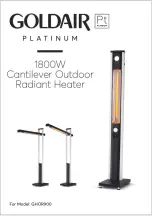
8
July 2020
recommended slope is 1/4 inch per foot,
sloped to drain.
It is recommended that an appropriately sized
Tempering Valve be installed on the solar tank
potable outlet connection per the
manufacturers instructions.
2.3. ELECTRICAL CONNECTIONS
A 6 foot electrical line cord is supplied from the
SolarStation HX. An electrical supply outlet
installed per approved methods per electrical
code for a 120VAC 1ph connection.
The temperature sensor installed on the array
outlet should be connected into the T1 terminal
block . The temperature sensor installed near
the bottom of the solar storage tank should be
connected into the T2 terminal block. The
upper tank temperature sensor should be
connection into the T3 terminal block.
The T1 array temperature sensor should be
installed in a dry thermowell on the array
outlet header connection as shown in
Figure
2.3.1
The T2 tank sensor should be installed in a dry
thermowell on the lower 1/6th of the solar
storage tank.
The T3 upper tank sensor should be installed in
a dry thermowell located at the hot outlet of
the solar storage tank.
3.1. CHECK THE ARRAY LOOP FOR LEAKS
1. Before the system has been charged, open
all shut
-
off valves on the collector loop.
2. Apply 20 psi less than the pressure relief
valve rating of pressure for 15 minutes.
Any drop in pressure during that time
indicates a leak.
3. Find the source of the leak and repair it.
Repeat this procedure until the loop holds
pressure.
3.2. FLUSHING THE SYSTEM
After installing the SolarStation HX the system
should be flushed. Piping in new solar
installations can be covered with dirt, grease,
solder flux or other impurities that over time
affect the quality of the propylene glycol HTF.
A thorough cleaning is required before
charging the system with propylene glycol
water mixture.
Step 1 –
Fill solar tank with water and ensure
there are no leaks on the potable side of the
system. Open the nearest hot water fixture
and run to flush out any flux from the
installation.
3.3. CHARGING THE SOLAR CIRCUIT
Once the system is flushed you are ready to fill
the solar storage tank with water and to
charge the collector loop with a mixture of heat
transfer fluid (HTF) and water. Due to
variations in municipal water quality
throughout the country, distilled or deionized
water shall be used to mix with the propylene
glycol HTF. Refer to
Table 3.3.1
for percent
concentrations.
1.
Connect the outlet of a transfer pump via a
hose to the fill valve(#5).
2.
Open the fill valve.
3.
Open the drain valve. Connect the drain
valve to a bucket(#4).
4.
Fill the bucket with the appropriate mixture
of propylene glycol and water.
5.
Run the pump. Continue running the pump
until you do not see air bubbles in the
coolant.
6.
Turn off the pump. Let the system sit for
3. SYSTEM COMMISIONING
Figure 2.3.1: T1 Array Temperature Sensor Installation
*Seal Temperature Sensor into thermowell with light coat of sealant




























